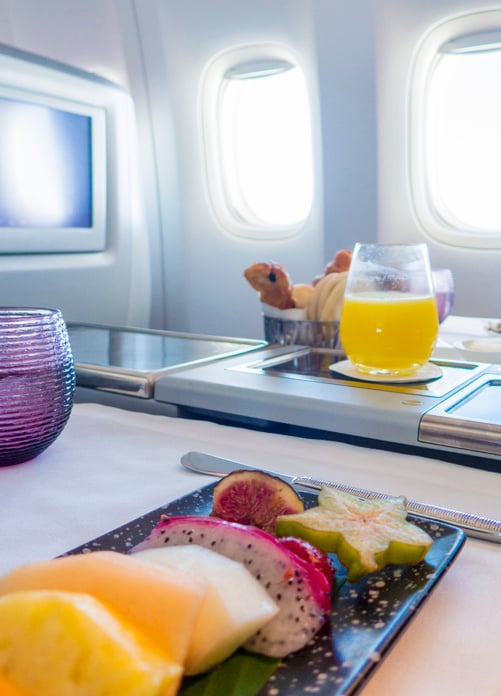When the airline industry ground to a halt in 2020, many airline catering companies were left with a large number of meals and no one to serve them to. To help make sure they didn’t go to waste (and I am guessing to also recoup some money), it was common during the pandemic to have airlines and airline catering companies sell meals to the public.
In June 2020, one of the airline caterers started doing this here in Australia. The Australian international borders were closed, with Australian citizens bared from leaving the country without a permit, and a strict cap on numbers of Australian citizens arriving into the country. Internal state borders were also shut and so flying within Australia and to/from Australia was severely limited. So just before another major lockdown in Victoria I headed out to the airport to pick up my order of 20 airline meals.
Why did I buy airline meals?
As a dietitian specialising in travel nutrition advice, I wanted to be able to review typical meals served in economy on airlines in more detail than when onboard. I was looking to review the ingredient list and nutrition information panel in detail, measure the vegetable content, taste test and check out the overall quality of the meals.
By reading this guide I hope you may have some insights into common airline meals and some of the takeaway food and nutrition traps to watch out for.
Which airline meals did I buy?
I chose the pack that included a variety of both vegetarian and non vegetarian meals. The meals that were included in the pack were:
- Beef Bourguignon
- Thai Yellow Curry
- Rigatoni Pesto Pasta
- Mei Goreng Noodle
- Chicken Mango Curry
- Potato and Ricotta Gnocchi
- Lemon Chicken
- Beef Mongolian with Egg Noodle Stirfry

Which meals were the best?
Food Quality
- The beef bourguignon for me was the best in terms of food quality and also taste. The beef was fairly tender and was mostly actual pieces of beef (not much gristle or fat). The ingredient list showed the beef was brisket, and it was listed as the first ingredient which means there should be more beef than anything else in the dish. The potato looked awful (you could actually see the scoop shape) however surprisingly it tasted nice and the texture was smooth. The ingredients for the potato mash were: potato, milk, cream and butter, which suggests it was real potato and not rehydrated (but I cannot confirm).

- The Chicken Mango Curry was also not bad. There were a number of pieces of fairly good quality chicken in the dish and enough sauce to provide flavour but without drowning the dish.

Nutrition
- Thai Yellow Curry had half a cup of colourful vegetables which was the most out of all the meals. So great to get 1/2 cup vegetables, but still only a small amount in the context of daily requirements but it is a start.
- Chicken Mango Curry had the lowest sodium (salt) levels with 74mg/100g (193mg/serve).
- Beef Bourguignon contained the lowest energy with 1200kJ/serve. There were 17g of carbohydrates per serve which was the lowest out of all the meals. Now, aiming for the lowest amount of carbohydrates in a meal isn’t always necessary to be healthy. However when flying long distances it is best not to fill up on refined, low fibre carbohydrates, and so choosing meals with lower amounts of carbohydrates can be beneficial.
Which meals were not great?
Food Quality
- The Thai Yellow Curry had what I thought was quite a watery sauce without much flavour.

- The noodles in the Mei Goreng Noodles and the Beef Mongolian Noodles were pretty dry and tasteless. There wasn’t really any sauce in the dishes to provide any moisture.


- The Rigatoni Pesto Pasta had a gluggy white sauce which did not coat the pasta well and so I felt like the dish was just a whole lot of pasta without much taste. There was also just a couple of pieces of pumpkin so this did not provide much flavour to the dish as a whole.
Nutrition
- Potato and Ricotta Gnocchi had the highest sodium levels with 566mg/100g (1270mg/serve). This is half the maximum recommended daily sodium amount which is a lot considering the meal size is actually quite small.
- The dishes with the highest carbohydrate content were the Rigatoni Pesto Pasta (69.8g ) and the Lemon Chicken (67.8g). For context this amount of carbohydrate is approximately equivalent to 3-4 average slices of bread. Now while eating this amount of carbohydrates in a meal is sometimes not an issue here I would say it is not a great feature due to the fact that people are quite sedentary on planes.
- The Lemon Chicken has no vegetables except a few peas which are more of a garnish and similarly the Pesto Pasta has a few cubes of pumpkin on top which also seemed like a garnish.

- The Beef Mongolian Noodles and the Rigatoni Pesto Pasta had two of the longest list of ingredients, and many of these ingredients were additives or double ups of ingredients (i.e. ingredients within ingredients that did not seem necessary).
Overall thoughts for the best and worst meals
Taking into consideration the overall meal, meaning the food quality, taste and nutrition, I would say Beef Bourguignon is the one that stands out the most for me.
The Lemon Chicken and Rigatoni Pesto Pasta would have to be the ones I liked the least overall. With the Lemon Chicken it was disappointing to see the additives in the actual chicken, and that the meal was basically chicken, a sweet sauce and rice. The calorie content of the Lemon Chicken was also quite high for a meal that didn’t really taste great and wasn’t packed with nutrient rich foods. The Rigatoni Pesto Pasta similarly was not a standout meal due to basically being pasta with a sauce and a few small pieces of pumpkin.
Takeaway findings on airplane meals
- Just because a meal is vegetarian on a flight doesn’t mean it will automatically be healthy or contain lots of vegetables. Sometimes vegetarian meals can be predominantly carbohydrate based foods such as pasta or rice with minimal vegetables (see the Rigatoni Pesto Pasta, and Potato and Ricotta Gnocchi below). However this is not always the case with some meals containing more vegetables than others for example the Thai Yellow Curry contains half a cup of vegetables which is double the Rigatoni Pasta meal. There are also different vegetarian styles of eating which may influence how many vegetables are in the meal, so it can be worth confirming this with cabin crew/reading the description online when choosing. For example these are the different types of vegetarian meals offered by Qantas, Emirates, Turkish Airlines and Finnair.

- The long list of ingredients for many of these meals highlight how many additional ingredients and additives are included. This means they could be considered ultra processed foods according to the NOVA system for classifying food. Additionally what is interesting to see is that many of the ingredients then have their own list of ingredients. What does this mean I hear you ask? For example the green peas in the Beef Bouguignon have the ingredients ‘green peas, vegetable oil, salt, pepper’, and the pumpkin in the Rigatoni Pesto Pasta has ‘pumpkin, vegetable oil, sugar, salt, pepper’. This could mean there is a double up of ingredients in the meal such as salt added to a sauce but then also salt added to vegetables in the sauce.

- Watch out for carbohydrate fillers in meals such as pasta, rice and noodles. While these foods fit nicely into healthy eating patterns, if they are the main ingredient then it can be an unbalanced meal. Eating it once off isn’t an issue but when you are flying and it is your meal on a long haul flight then you aren’t getting many nutrients. Take the Rigatoni Pesto Pasta meal as an example, it is basically only pasta with a pesto sauce and approx. 1/4 cup of small pumpkin cubes.


- The sodium (salt) content of some airline meals is a lot higher than others and should be taken into consideration when thinking about the healthiness of airline meals. While it is thought the way we taste can change when we are flying, adding salt to the meals is not necessarily the answer. Flying in general promotes dehydration and so it is important to not overdo the salt!
- The quality of meat can sometimes be questionable with very chewy/gristly meat being served in dishes. When choosing a meal containing meats such as beef or chicken, you might like to ask the cabin crew some questions regarding how the meat is served or whether there has been previous feedback on the quality. This is because usually there are only small amounts of meat present in these types of airline meals (I am not referring to steaks etc served in some first/business class) and sometimes the meat pieces can be mostly fat or gristle. Also sometimes the meats are processed and have additional ingredients such as the actual chicken (not the crumb) in the Lemon Chicken contains “chicken, water, potato starch, modified starch, ginger, thickener (E1422) soy sauce, mineral salts, sugar, salt, chicken powder”. As you can see the chicken is not just chicken that has been crumbed and coated. It is chicken that has been processed and then crumbed.

Please note these airline meals were reheated according to the instructions on the label e.g. microwave or oven. Also note the expiry date was in 2020 – I bought these meals in 2020 and tasted/reviewed them then too. I have posted this article now due to the reduced flying that was happening around the world in 2020/2021.
All pictures of airline meals are my own and I review a lounge from just the foods and menu I see during my visit. There may be different options available at other times. I love hearing from you and what information you need so please reach out to me if you want me look at any specific meals.



